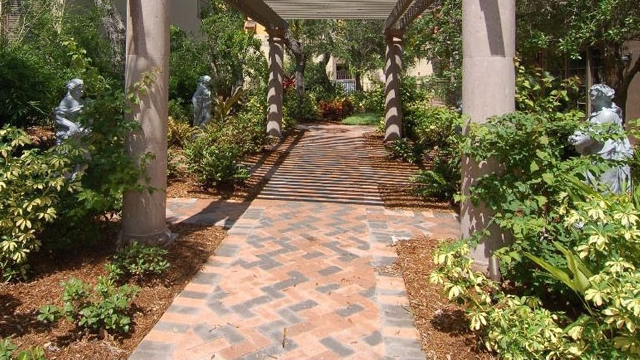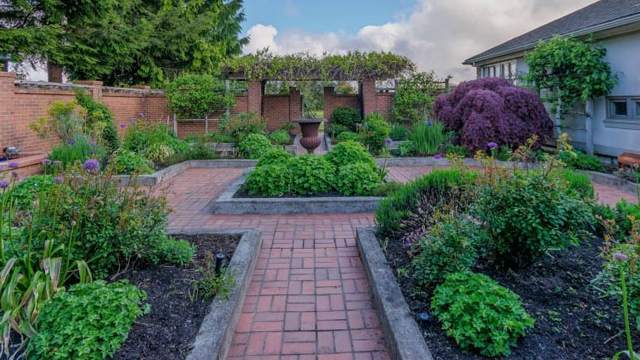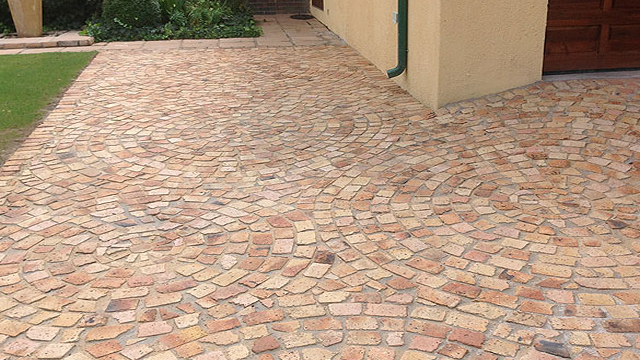How do Interlocking Pavers Work?
The first reason that concrete pavers – and any paver that interlocks – has to do with the material that they are constructed from. Concrete pavers are rated multiple times stronger than poured concrete. This is due in part to the way the pavers are formed, but it’s also due to the ‘interlocking nature’ of the material.
The Interlocking Action
Interlocking pavers remain durable and new looking even after years of abuse and weather precisely due to the ‘interlocking action’ of the paving stones. Interlocking concrete pavers are designed specifically to leave gaps in between each brick – in other words, they do not sit exactly flush to each other. It is this space, paradoxically, that gives the entire structure its strength as soon as these joints are filled with an appopriate joint material, such as sand. The pavers are laid in a particular pattern (the pattern really is just how the joints are arranged), leaving a bit of space in between each and every paver. Mortar is not used to bind these joints together, as this would destroy the benefits of the sand-interlocked paver.
Though sand is the most popular material used for the joints, it is not the only one – special joint material is put out by the concrete paver companies for this purpose, but it’s generally quite expensive. Bluestone screenings are another popular material, though there may be problems with this material when the surface is compacted, as the small stones may scratch the surface of the brick. Thus, sand remains the most popular joint material for most projects and contractors.
How the Interlocking Works
When the sand fills the joints, it helps hold the pavers together in two ways. First, the small pits and holes in the stone interlock pavers through friction. The small gaps ‘join together’ and help the paving stones cohere. The sand also fills these holes, increasing the friction between the pavers even more. Second, the sand itself, when compacted, gets very tight. Thus, not only does the sand help the pavers stick together, it actually helps all the sand stick together as well, as the closely packed grains of sand cannot move without great force (this movement is resisted by friction). When the entire structure is surrounded with edging and compacted, it holds together as a whole even though the paving stones are not directly touching each other across their entire faces.


Herringbone paving pattern
Laid in an alternating V-shape the Herringbone is known to be a durable and very stable paving pattern. It is a true classic and the design originated in the old English landscape. The Herringbone paving pattern has a strong visual impact and is a very popular choice when it comes to driveways, patios, and walkway paving patterns. The Herringbone paving pattern is created when pavers are laid at either 45 or 90 degrees to each other with the starting angel determine the overall paving pattern. The Herringbone pattern is a bit more time consuming because of so many paving bricks that need to be cut but the eye-catching effect it creates makes it well worth the effort.

Basketweave paving pattern
Laid in pairs alternating between horizontal and vertical pavers the Basketweave is easy to get started with and creates a historic look with a vintage twist. The Basketweave paving pattern can be used in combination with paving tiles and alternating clours to give a truly creative finish. If you do a bit of planning the Basketweave paving pattern will not require any cutting. The Basketweave paving pattern is commonly used in the patio, pool and entertainment areas. It is also used when reclaimed bricks are used for paving where the pattern draws the eye away from any imperfections.

Running bond paving pattern
Laid end to end with new rows joints positioned in the middle of the previous row the Running bond paving pattern is the most common of all paving pattern options. It is easy to install making it one of the most popular and frequently used paving pattern. Commonly used in residential landscaping, walkways, patios and entertainment areas the Running bond pattern is very durable/strong and can handle significant weight. The running bond pattern is also ideal for curving garden paths as the pattern can flex to follow the curves. The Running bond pattern is also sometimes referred to as the Stretcher Bond paving pattern.

Stack bond paving pattern
Laid side by side with all the joints inline the Stack bond paving pattern creates strong, visual lines and is used in walkways and smaller areas. The linear lines of the Stack bond pattern are great to make a small space look bigger and it works wonders in a small patio. The Stack bond paving pattern has a relatively low structural value and is most often used for aesthetic purposes only. It is also a very eco-friendly pattern option and requires very little cutting with almost zero waste. When installing the paving bricks great care should be taken to follow the line and keep the paving bricks tight together in a straight line. Borders should be set in concrete to ensure the paving pattern stay in tack.

Circular paving pattern
Starting in the center laying bricks in a circular pattern outward to create the circular pattern. Natural shapes like the circular paving pattern are trendy and most commonly used in gardens and driveways. Circular paving is used to create interesting focal points and if installed correctly will turn heads! The circular pattern works great in a round seating area, a boma setup or a starting point for driveway paving. Depending on paving material used the circular paving pattern is challenging to plan, very labor intensive and will require a lot of cutting if reclaimed bricks are used for paving. Our paving consultants are on standby if you need any advice or someone to do it for you!

European fan paving pattern
Laid in a series of arcs the pattern is repeated a few times to get the desired circular effect. The pattern only really works with cube type paving and is very complicated to set out and only works in larger settings. However, it is such a visually pleasing layout that it is easy to understand why it has been such a hit in Europe. The fan pattern also makes it possible to play with contrasting colours to create eye-catching focus points. In a residential setting, the fan pattern can be used at the entrance of a driveway or a patio. The European fan paving pattern is also known as the Belgian pattern or Florentine pattern.

Laid side by side the square cobbles creates an aesthetically appealing look and can be used in driveways, pathways, flower bed edging and patios. It is easy to install and lend itself to be used in a wide range of patterns and designs. The square cobblestone paving pattern is a true classic and will give any property a unique and customized look. The cobblestone paving pattern can be applied to commercial, residential, and public spaces to create a worn “Old European” look. It is a strong paving stone that is maintenance-free with very little cleaning effort and most popular paving blocks for driveways.

Interlocking paving pattern
Available in 60 mm and 80 mm and working together as a system each concrete paver is dry cast in specific forms to keep the next paver tightly in place. Interlocking pavers are usually laid in a Herringbone pattern to obtain the most strength and stability. It is durable and it’s ecstatic characteristics make it a popular choice. The 60 mm Interlocking paver is used for light industrial use and can be applied to driveways, walkways and parking areas. The 80 mm Interlocking paver is used in heavy industrial applications and can be applied to factory driveways, access roads, and petrol stations.

